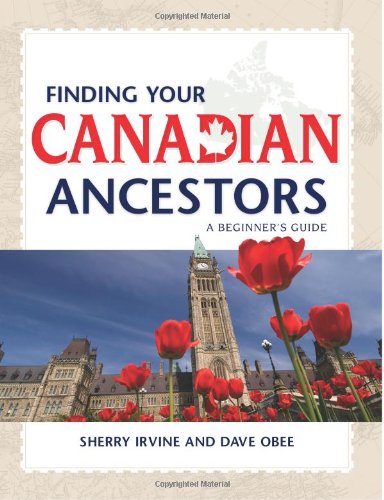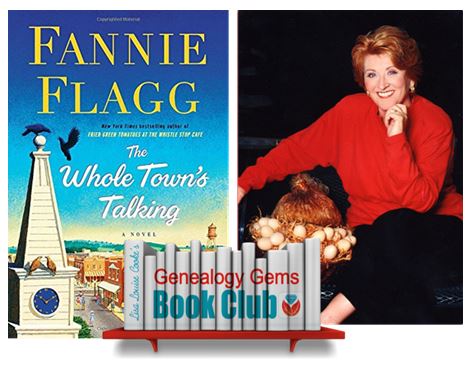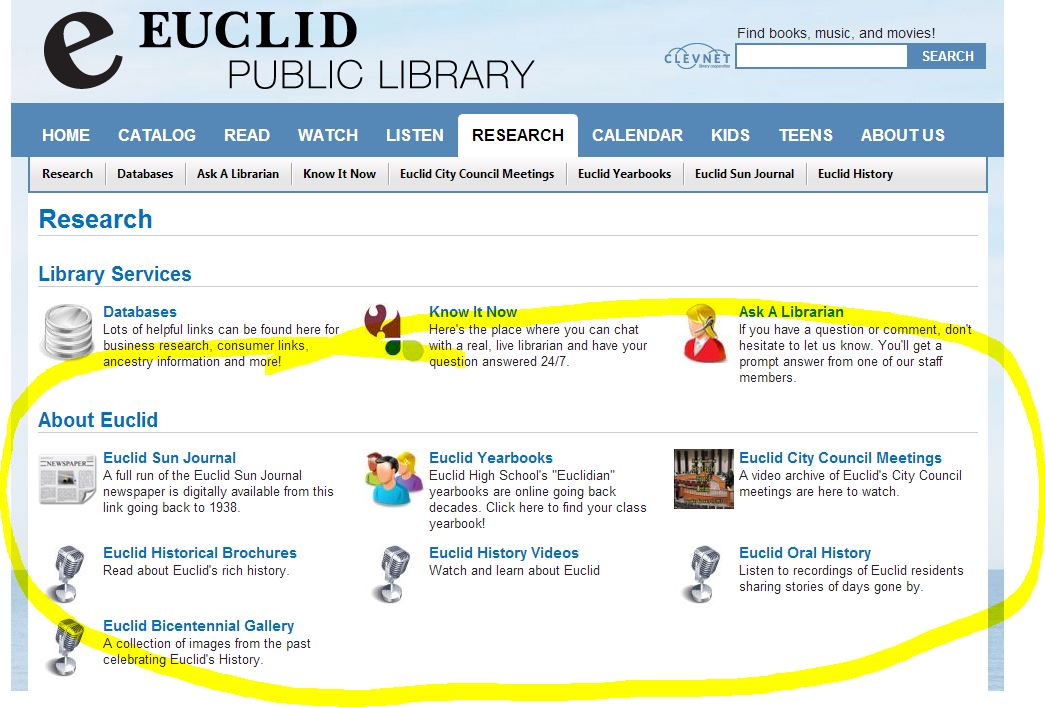Episode 203
The Genealogy Gems Podcast
with Lisa Louise Cooke
Episode #203

This episode features a special interview with renowned Canadian expert Dave Obee. He shares his favorite tips on researching the Canadian census?his insights are fascinating whether you have Canadian ancestors or not!
Also in this episode: an inspiring adoption discovery, DNA testing news at 23andMe, a tip for incorporating family history into a wedding, and a brand-new resource that can finally help you solve one of genealogy’s most perplexing questions.
NEWS: ATLAS OF HISTORICAL COUNTY BOUNDARIES UPDATE
Atlas of Historical County Boundaries
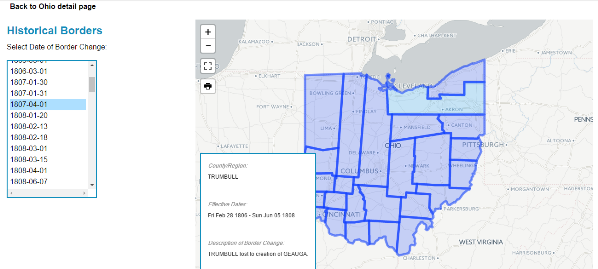
Google Earth for Genealogy (and more on Google Earth Pro)

LINK: https://lisalouisecooke.com/free-google-earth-for-genealogy-video-class-by-lisa-louise-cooke/
NEWS: 23andME DNA TEST UPDATES
Click here for the full news and Diahan’s comments
MORE recent DNA news:
Family Tree DNA enhancements:Click here for the full story, with comments and step-by-step instructions on updated myOrigins tool
Get help with DNA testing at both these sites with these quick reference guides by Diahan Southard:

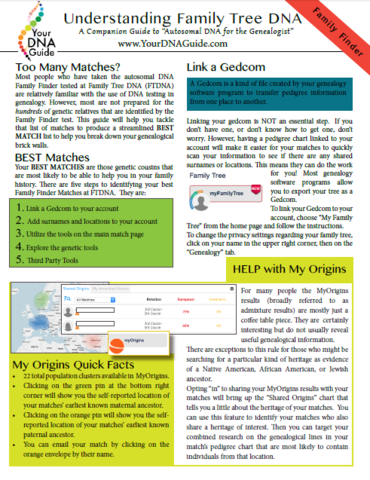
NEW! GENEALOGY GIANTS GUIDE
by Genealogy Gems Editor Sunny Morton
Click here to watch the presentation that inspired this guide: a popular RootsTech 2017 lecture comparing the four major genealogy records websites: Ancestry.com, FamilySearch.org, Findmypast.com and MyHeritage.com.

LINK: https://www.shopgenealogygems.com/collections/genealogy-guides/products/genealogy-giants-quick-guide
Available in print or digital format
This comprehensive quick reference guide explains:
How knowing about all four websites can improve your family history research
How the sites stack up when it comes to the numbers of historical records, names in trees, DNA profiles, site users, site languages and subscription costs
Unique strengths of each website and cautions for using each
What to keep in mind as you evaluate record content between sites
Geographic record strengths: A unique table has an at-a-glance comparison for 30+ countries
How to see what kinds of records are on each site without subscribing
How family trees are structured differently at these websites?and why it matters
Privacy, collaboration and security options at each site
How DNA testing features differ at the two websites that offer it
What you can do with free guest accounts at each website
Subscription and free access options
MAILBOX: LIZ ON FINDING CHUCK’S BIRTH FAMILY
Click here to learn more about Diahan Southard’s genetic genealogy video tutorials?and a special discount price for Genealogy Gems fans.
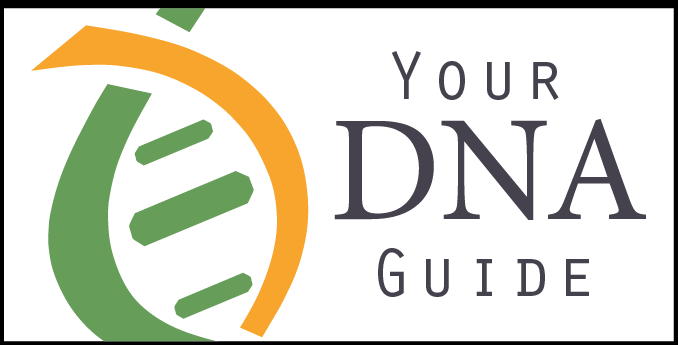
LINK TO: https://www.yourdnaguide.com/genealogy-gems-dna-tutorial
Lisa Louise Cooke uses and recommends RootsMagic family history software. From within RootsMagic, you can search historical records on FamilySearch.org, Findmypast.com and MyHeritage.com. In the works: soon RootsMagic will be fully integrated with Ancestry.com, too: you’ll be able to sync your RootsMagic trees with your Ancestry.com trees and search records on the site.
Keep your family history research, photos, tree software files, videos and all other computer files safely backed up with Backblaze, the official cloud-based computer backup system for Lisa Louise Cooke’s Genealogy Gems. Learn more at http://www.backblaze.com/Lisa
MAILBOX: THANKS FOR 1940 CENSUS TIPS

Kate Eakman shares tips for understanding the 1940: click here to read them or click here to listen to them on Genealogy Gems Podcast episode 201
MAILBOX: WEDDING TIP
Before a wedding: start an online family tree and invite each family member to add what they know!
Share family history this summer: Reunions, weddings, BBQs, etc
Genealogy Gems Pinterest Page: Incorporating Family History Ideas into Your Wedding

Go to: https://www.pinterest.com/lisalouisecooke/incorporating-family-history-into-your-wedding/
Our sponsor for this episode: StoryWorth
Give Mom the gift of StoryWorth this Mother’s Day
Visit www.StoryWorth.com/Lisa to get $20 off
Visit: www.StoryWorth.com/Lisa
INTERVIEW: DAVE OBEE

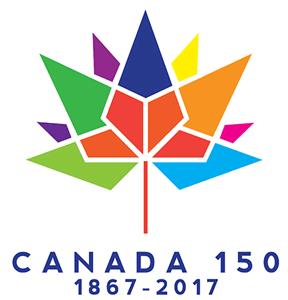
Continuing our celebration of Canada’s 150th birthday!
Dave Obee is an internationally-renowned Canadian journalist, historian and genealogist. Dave is a columnist for Internet Genealogy and Your Genealogy Today (formerly Family Chronicle). Dave has also written about family history for Canada’s History and Your Family Tree in the United Kingdom.
Put Dave’s books on your shelf:
Finding Your Canadian Ancestors: A Beginner’s Guide
Counting Canada: A Genealogical Guide to the Canadian Census
Destination Canada: A Genealogical Guide to Immigration Records
Making the News: A Times Columnist Look at 150 Years of History
Canadian census tips from Dave Obee:
The 1901 census is his favorite because it says for the first time where people had come from
He starts his searches on Ancestry.ca but census databases are free to search on Library and Archives Canada website
Marital status may not have been totally accurate. They only captured single or married or windowed. Divorced was not captured.
There are two different types of enumerations: de facto and de jure, and the rules were different.
This means your ancestor could be enumerated in multiple locations
Lisa Louise Cooke Googled the Canadian Census Enumerator Instructions for 1901:
Original instructions digitized at Archive.org
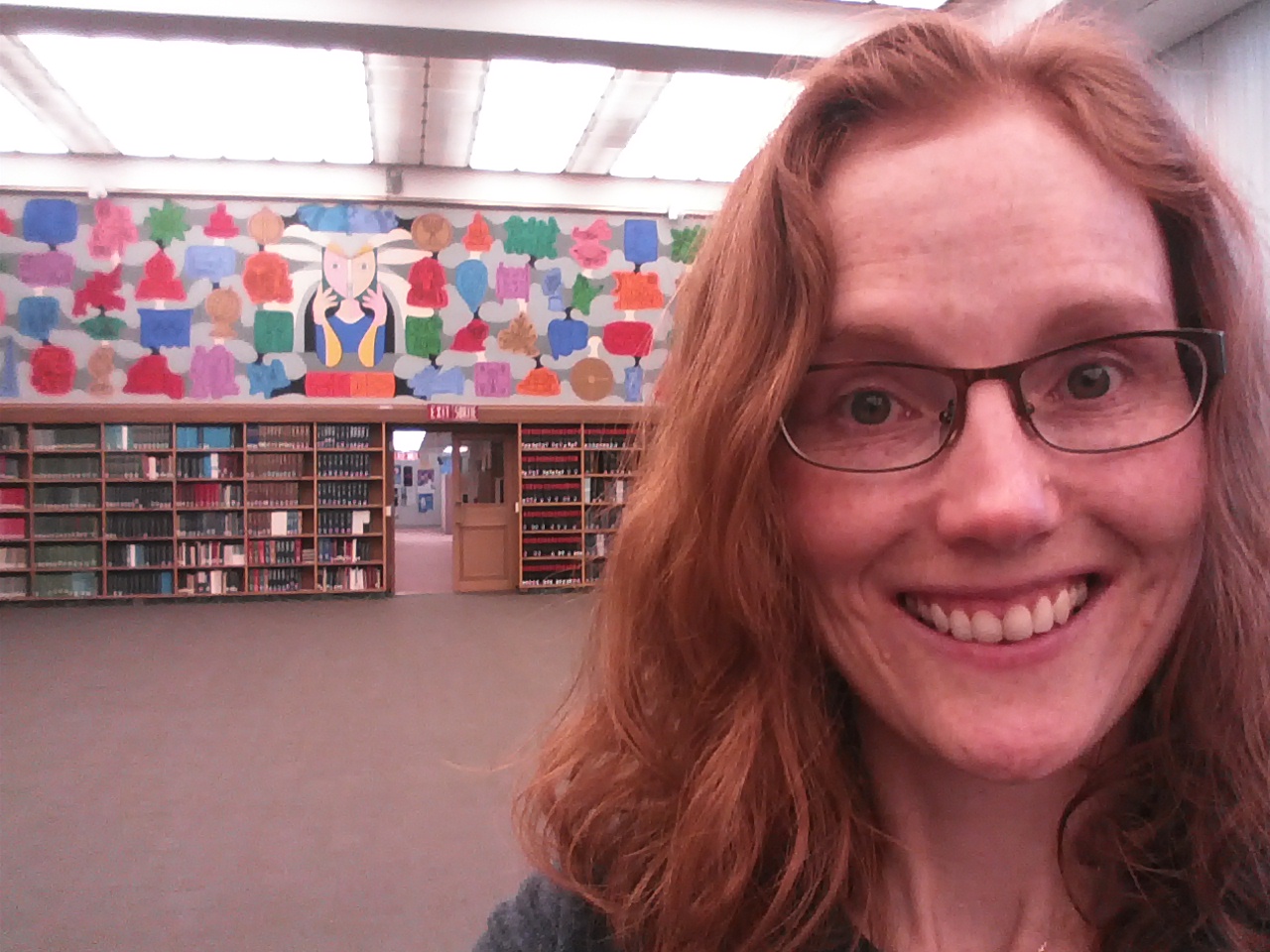
More on Canada genealogy research:
Claire Banton in Genealogy Gems Podcast episode #199
Blog post on Canadian Censuses 1825-1921
Search Canadian Passenger Lists for Free at Library and Archives Canada
Canadiana: Canadian Digital Archive and Portal to the Past
Google Earth for Canada and Genealogy
Our Sponsors:
Start creating fabulous, irresistible videos about your family history with Animoto.com. You don’t need special video-editing skills: just drag and drop your photos and videos, pick a layout and music, add a little text and voila! You’ve got an awesome video! Try this out for yourself at Animoto.com.
MyHeritage.com is the place to make connections with relatives overseas, particularly with those who may still live in your ancestral homeland. Click here to see what MyHeritage can do for you: it’s free to get started.
BONUS CONTENT for Genealogy Gems App Users
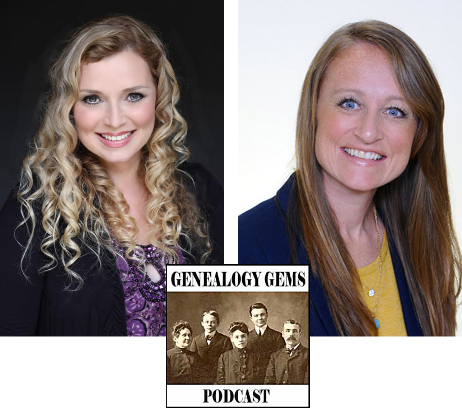
If you’re listening through the Genealogy Gems app, your bonus content for this episode is EXTRA special! It’s an exclusive conversation between Your DNA Guide and Cece Moore of DNA Detectives on researching adoption or unknown parentage. Don’t miss it! The Genealogy Gems app is FREE in Google Play and is only $2.99 for Windows, iPhone and iPad users.
GENEALOGY GEMS BOOK CLUB
Our featured genealogy book club author this month is Miss Fannie Flagg!
The Whole Town’s Talking by Fannie Flagg
Read more tips on discovering the historical context of your ancestor’s lives:
Tell Your Ancestor’s Story: Use Social History for Genealogy
Social History for Genealogy and the Colored Farmer’s Alliance
PRODUCTION CREDITS
Lisa Louise Cooke, Host and Producer
Sunny Morton, Editor
Diahan Southard, Your DNA Guide, Content Contributor
Lacey Cooke, Service Manager
Vienna Thomas, Associate Producer
Check out this new episode!
Free Genealogy – How to Find Free Genealogy Records
Elevenses with Lisa Episode 21 Video and Show Notes
Live show air date: August 20, 2020
Join me for Elevenses with Lisa, the online video series where we take a break, visit and learn about genealogy and family history.
How to Find Free Genealogy Resources
In the genealogy community it’s often said, “Only a fraction of genealogical records are online.” That’s true indeed, but it’s not a reason not to start your search online. A more helpful and accurate piece of advice would be “while not everything is online, all search for genealogical information starts online.”
The reason for this is simple. Online research before you go will reveal:
- If the materials are available at a more convenient location
- If the materials are available somewhere online for free
- The call number, location, and other specific information you need to quickly access the materials once you arrive.
- Details about gaining access to the facility and materials.
The last bullet point above will help you avoid the disappointment of discovering an unforeseen closure, or that the specific records you need are actually help at a satellite location.
New genealogical information and records are uploaded daily to the internet. Some of this information is available for free. In this article and episode we will cover strategic ways to locate and access free genealogy online.
The Amount of Data Continues to Increase – Read more about the growth of online information here.
The Path of Least Resistance to Free Genealogy
Most genealogists want to obtain records at the lowest available cost with the least amount of travel. Therefore, always starting your search online just makes good sense.
Here’s our path of least resistance:
- Free and Online: FamilySearch, Google, WorldCat
- Online and Subscription: Ancestry, MyHeritage, Findmypast, niche sites
- Free and Locally Offline: Libraries, Archives, Universities
- Offline and Distant: Examples include the National Archives, Allen County Library, Family History Library, NEHGS
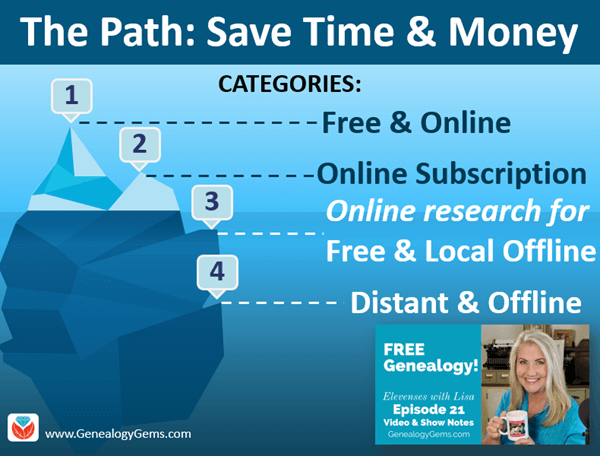
www.GenealogyGems.com
Free Genealogy Records Online
FamilySearch
FamilySearch is a free genealogy website.
The FamilySearch Catalog: New digitized images are added daily from microfilms & digital camera operators. These include books, maps, compiled family histories, and more. The catalog also includes materials that are not online but are available at the Family History Library in Salt Lake City or through Inter-library loan.
The FamilySearch Wiki is a free online genealogical guide comprised of more than 93,000 articles. It covers 244 countries, territories, and islands. It includes links to genealogy databases and online resources as well as how-to information.
Use the FamilySearch Wiki Watchlist to follow pages of research interest. Here’s how to watch Wiki pages for new and free genealogy content:
- Log in with your free FamilySearch account
- navigate to the desired page
- click the Watchlist link in the upper right corner of the page.
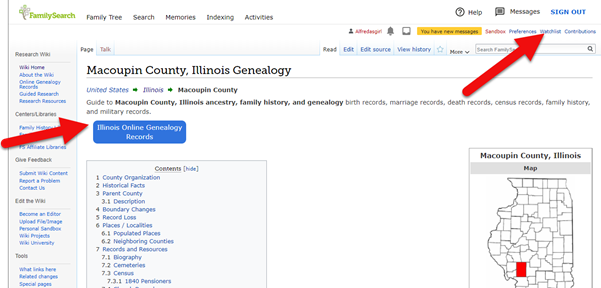
Look for the Watchlist link, and the blue buttons that lead to free online genealogy records for that location.
Google.com
Google is still your best bet for finding sources both online and offline.
You can dramatically improve your search results by incorporating search operators into your search. Watch episode 13 of Elevenses with Lisa to learn about how to use search operators when googling for genealogy.
Get all of the Elevenses with Lisa episodes here.

Learn how to google for free genealogy in episode 13.
Find More Free Genealogy with these Google Search Strategies
The most comprehensive and best-selling book on the topic of using Google for genealogy:
The Genealogist’s Google Toolbox, by Lisa Louise Cooke.
Google Alerts Finds Free Genealogy for You
Set up free Google Alerts to be on the lookout for new and updated search results. You’ll receive them by email, and you can control the frequency.

Google Alerts do the work of searching for free genealogy for you.
How to Create a Google Alert:
- Highlight and copy (Control C on Windows or Command C on Mac) the search query that you typed into the Google search box
- Go to www.google.com/alerts
- Sign into your free Google account
- Paste (Control V or Command V) your search query into the Search Query box on the Google Alerts page
- Select the Result Type you desire (ex. Everything, News, etc.)
- Select how often you wish to receive alerts
- Select How Many results you want to receive (I recommend Only the Best Results)
- Enter / Select the email address you want your alerts to be sent to
- Click the Create Alert button
Partnerships Make Free Genealogy Available
Many of the genealogy giants enter partnerships with each other in order to facilitate digitization and indexing of genealogical records. This means that the same materials may be found in different locations on the web, and sometimes for free.
WorldCat.org
17,900 subscribing member libraries in 123 countries collectively maintain WorldCat’s database which is the world’s largest bibliographic database.
Use WorldCat to check that you are indeed accessing the resource from the most convenient repository and if it’s available for free. Here’s how:
- Run your search
- Click an item
- Under Find a Copy in the Library enter your zip code
- The library closest to you will be listed at the top
Once you get your search results, look to the left in the Formats box. There you can quickly narrow down to only items that are online by clicking boxes like Downloadable Article. Some of these may require a log in on the website you are referred to.
How to Find Free Records at Genealogy Websites
Ancestry.com
If you don’t have a paid subscription to Ancestry.com you can still take advantage of their many free collections available here. Then read my article Why Use Ancestry for FREE if You’re NOT a Subscriber for more tips of free stuff at Ancestry.
MyHeritage.com
To find free records at MyHeritage.com, go to https://tinyurl.com/LisaMyHeritage. In the footer menu of the website, click on Historical Records. Then fill in your search criteria. (Update: If you don’t see Historical Records in the footer, go to Research > Collection Catalog and search on the keyword “free.”) Scroll down the search results and look for the green free tags.
Findmypast.com
To find free records at Findmypast which specialized in British genealogy but also includes records from around the world, go to https://tinyurl.com/FMPLisa.
(Some links in our articles are affiliate links. We will be compensated at no additional cost to use when you use them. This makes it possible for us to bring this free show to you. Thank you!)
Google Site Search Can Help Locate Free Genealogy
A site search works like many search operators as previously discussed in Elevenses with Lisa episode 13 (watch and read here.) It provides Google with specific instructions about the type of search you want to conduct with your search terms and keywords.
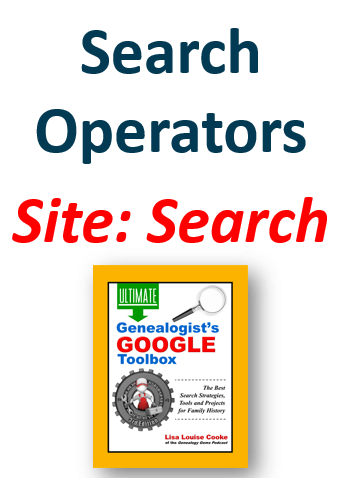
This Site search tip comes from Lisa Louise Cooke’s book The Genealogists’s Google Toolbox.
Site search runs your query only on the specified website. This is extremely helpful and efficient if:
- you have a particular website in mind that you want to search,
- you aren’t having success using the search field provided by the website,
- the website you want to search doesn’t have a search field.
Here’s an example of a Site search:
Free Pennsylvania site:ancestry.com
Try running the search above for yourself. You’ll find results that include many free genealogy records pertaining to Pennsylvania. Substitute the words to meet your search needs.
Construct a Site search for Free Genealogy by first typing in the words and phrases you wish to search for. Include the word free. Leave the appropriate spacing between them and follow the last item with a space. Then type site: and add the website home page address (URL). You can copy the URL and simply paste it in place. There is no space between the colon and the URL. And note that www is not required.
Searching for Offline Local Sources with Free Genealogy Information
To find what’s local and free:
- Search WorldCat.org (be sure to use the Zip Code filtering to find the genealogy materials at the location closest to you.)
- Use Google to search.
- Find your local Family History Center here. These centers have unique free resources as well as free access to some subscription genealogy websites.
When you find a library, archive or other repository, visit their website and look for:
- Databases they offer
- Their online catalog to plan your research
- Other associated libraries
- Details on planning a visit
Get Free Genealogy Help on Facebook
Search for Random Acts of Genealogical Kindness (RAOGK) on Facebook.
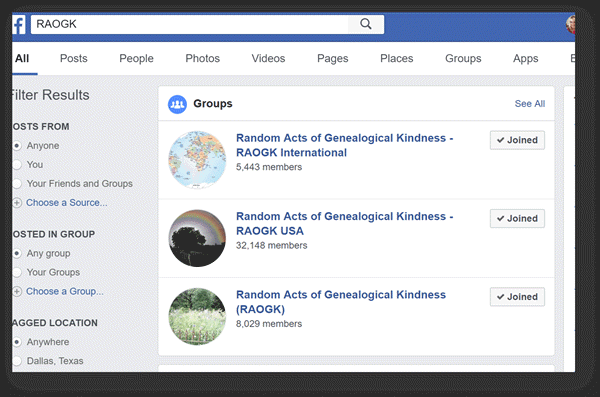
Get free genealogy records help on Facebook.
Learn More with these Resources
- Genealogy Gems Premium Membership: Genealogy & DNA video classes.
- The Genealogist’s Google Toolbox, by Lisa Louise Cooke.
- Genealogy Giants: Comparing the 4 Major Websites Quick Reference Guide.
Free Tools at MyHeritage for a Limited Time
Now through Sept. 10, 2020 you can get free access to Myheritage Photo Enhancer and MyHeritage In Color here.
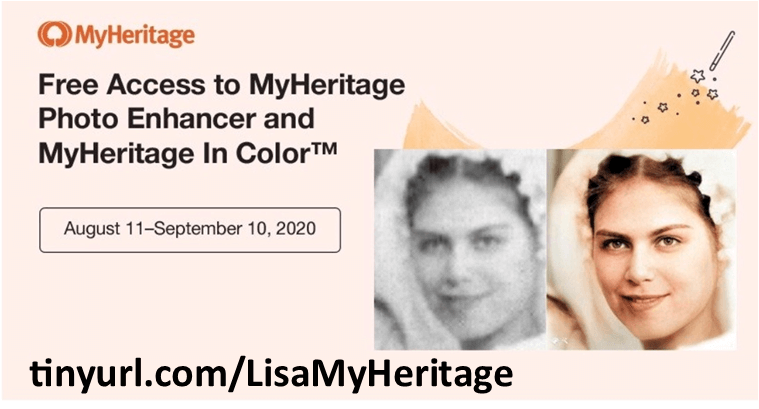
Resources for this Episode
- Live show chat log
- Premium Members: Download the show notes handout
New Records Include Irish Genealogical Abstracts
Explore new Irish Genealogical Abstracts that have become available this week. They are a great alternative to records destroyed in the 1922 Dublin fire! Also new are church and burial records for England, poorhouse records for Scotland, German military recruitment, documents, and colonial letters for Australia. Finally, a variety of exciting collections are now online for the U.S. for Massachusetts, New Mexico, Georgia, and more!

Irish Genealogical Abstracts
New this week at Findmypast are several genealogical abstract collections! First is the Thrift Irish Genealogical Abstracts, created by renowned Irish genealogist Gertrude Thrift. This collection features copies of wills, bill books, parish registers, commission books, and freeman lists, as well as detailed family trees and pedigree charts. Records in this collection date as far back as the 16th century and up to the early 20th century.
Next is the Crossle Irish Genealogical Abstracts collection. Explore the various notebooks of 19th-century genealogists Dr. Francis Crossle and Philip Crossle to reveal a wealth of Irish genealogical resources including copies of records destroyed in the fire at the Public Record Office in Dublin in 1922.
Finally, the Betham Irish Genealogical Abstracts features abstracts and genealogical sketches created by herald Sir William Betham, the Ulster King of Arms. The notebooks are an excellent substitute for missing records and include abstracts of wills, reconstructed family trees, and detailed pedigrees.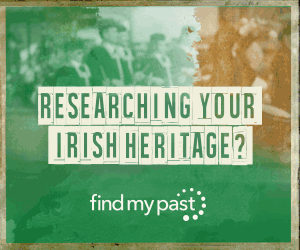
Also new for Irish genealogy this week is the Cork, Pobble O’Keefe Census 1830-1852. Search these records to discover who your ancestor was living with as well as their occupation, birth year and marital status.
Findmypast is the leader in genealogical records for Ireland, the UK, and now including U.S. and Canada. Get a two-week free trial of their premium subscription and explore millions of Irish record and more! Click here to subscribe now.
England Parish Records
Extracted Church of England Parish Records, 1538-1837 for Nottingham, England are now available online at Ancestry.com. The records include baptisms/christenings, burials, marriages, tombstone inscriptions, obituaries, tax lists, wills, and other miscellaneous types of records.
Over 75,000 records have been added to Findmypast’s collection of Yorkshire Burials, covering Anglican parishes and municipal cemeteries. Find your ancestor’s name, age at death and burial place, with more than 4 million records covering over 400 years.
Scottish Poorhouse Records
New for Scotland are Kirkcaldy, Fife, Poorhouse Records, 1888-1912. This collection includes records for those who received help from the Abden Home Poor Law Institution, originally named the Kirkcaldy Combination Poorhouse.
German Military Records
 Halle(Saale), Military Recruitment Lists, 1828-1888 are now online at Ancestry.com.
Halle(Saale), Military Recruitment Lists, 1828-1888 are now online at Ancestry.com.
From the collection description: “These recruitment lists are arranged in chronological-alphabetical order and contain detailed information about male military personnel in the city. Typically records for young men begin at age 20. Therefore this collection includes age groupings for men born beginning in 1808 up to and including 1868.”
Australia – New South Wales
At Ancestry.com, you can now explore the New South Wales, Colonial Secretary’s Letters, 1826-1856 collection. If you had ancestors living there during that time period, you can find a wealth of information in this collection, including petitions by convicts for sentence mitigation, marriage permission requests, character memorials for potential settlers, land grant or lease applications, official visit reports, information about court cases, and lists of assigned servants.
United States – Maps & More
Confederate Maps. The Cartographic Branch of the National Archives has announced the digitization of over 100 Confederate maps from Record Group (RG) 109. All are now available to view or download through their online catalog. “These maps can include rough sketches created quickly before or during a battle, but can also include maps that were drawn to accompany official reports or even post-war publications. Many are highly detailed and colorized.”
Massachusetts. At AmericanAncestors.org (the website of the New England Historic Genealogical Society), 12 new volumes have been added to the parish of Immaculate Conception in Salem to Massachusetts collection, Roman Catholic Archdiocese of Boston Records, 1789-1900. This update consists of 23,972 records and roughly 90,300 names.
New Mexico. Bernalillo County, New Mexico, Marriage Index, 1888-2017 are now available online at Ancestry.com. The original records come from Bernalillo County Record’s Office, Albuquerque, New Mexico.
Georgia. From a recent press release: The Digital Library of Georgia (DLG) is celebrating its 1 millionth digitized historic newspaper page. The premier issue of the Georgia Gazette, Georgia’s first newspaper, published from 1763-1776 in Savannah, will become the 1 millionth page of historic newspapers to be made freely available online through the Georgia Historic Newspapers (GHN).
Colorado. Also celebrating a 1 million milestone is the Colorado Historic Newspapers Collection (CHNC), from the Colorado Virtual Library. The millionth page came from the Montrose Daily Press, Volume XII, Number 247, April 21, 1921, which is part of a digitization project supported by Montrose Regional Library District.
Disclosure: This post contains affiliate links and Genealogy Gems will be compensated if you make a purchase after clicking on these links (at no additional cost to you). Thank you for supporting the free Genealogy Gems podcast and blog!
5 Genealogy Resources to Look For at YOUR Public Library

genealogy at the public library
This week, I’m researching at the Allen County Public Library in Fort Wayne, Indiana, which has one of the best public library genealogy collections in the United States. They’ve got more than half a million items on microfilm and fiche and 350,000 more in print. Among these items are nearly 50,00o city directories; 55,000 compiled family histories; most National Archives microfilmed military service and pension records….Okay, I’ll stop before you get jealous.
But in fact, MOST public libraries have some good genealogy resources. Have you checked out the library near you lately? OR the local history and genealogy collection in a public library near where your ancestors lived? You may likely find these 5 great resources:
- Access to paid subscription genealogy websites like Ancestry.com Library Edition, HeritageQuest Online, Fold3 and other genealogy databases.
- Local historical newspapers–or at least obituaries from them. ALSO access to historical newspaper websites like GenealogyBank.com which may have papers you’ll never travel to see in person.
- City directories, old maps and/or local histories for that town.
- Surname files. These aren’t at every public library, but you’ll often find them in libraries that have dedicated genealogy rooms. These likely won’t be neatly organized files with perfect family trees in them, but collections of documents, bibliographic references and correspondence relating to anyone with that surname.
- Other surprising local history resources. For example, my hometown library in Euclid, Ohio, has online collections of Euclid newspapers, history, yearbooks and oral histories!
What does your library have? Browse its website or call and ask about its local history and genealogy collections. You might even Google the name of the county with the phrases “public library” and “local history” or “genealogy.” Another branch of the same library system (not in your own or ancestor’s town but nearby) might have just what you need to find your family history!

Listen to the Family History: Genealogy Made Easy podcast by Lisa Louise Cooke. It’s a great series for learning the research ropes and well as refreshing your skills.
Want to learn more about doing genealogy at the public library? Check out two recently republished episodes of Lisa’s Family History Made Easy podcast:
Episode 34: Do Your Genealogy at the Public Library, Part 1 Genealogy librarian Patricia VanSkaik talks to us about researching at public libraries. She shares what kinds of things may be at the library (including unique resources), how to prepare for a visit and lots of great tips for making the most of your research time there.
Episode 35: Do Your Genealogy at the Public Library, Part 2 We go deeper into genealogy research at the public library. Genealogy librarian Patricia VanSkaik is back to talk about how to search an online library card catalog including advanced search methods, the unique collections that may be at public libraries, how to ask for exactly what we want, and the obstacles librarians face when it comes to cataloguing large and unique collections that may interest genealogists.




